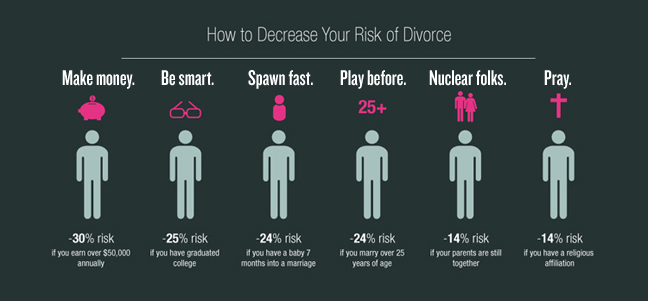Based on the annual report by The National Marriage Project, the following infographics reveal what we’ve known for some time: that the relevance of marriage with regards to how we live is evaporating. The famous stat that 50% of marriages end in divorce is common knowledge, but it is the effect — not the cause. The brilliance of the following infographics created by Tiffany Farrant and Promotional Codes™ is their focus on the various causes of marriages falling apart, not simply the final result.
The world of infographics is in a golden age at the moment. For some reason we’ve reached a tipping point over the past year or so, and in this short time I’ve seen more stunning work in information graphics than I have ever seen in my entire life. I’ve compiled my own collection of favorites over the past several months here at FEELguide and you can see them all HERE. As for this newest addition, like any great infographic, it gathers data and assembles it with such strong visual sensibility that the information is absorbed and understood much more quickly and much more cohesively. Notice in this first one how it takes the following information: 66% of women over 15 were married in 1960 and the figure has shrunk every decade where it is now just 51%. To present this information the designers took each decade’s figure and integrated them into a “clock” graphic beginning at 12:00am. The 1960 figure (66%) gets it 8 hours ahead, whereas the 2009 figure (51%) only puts it 6 hours ahead. As you’re taking in the following information, try and put yourself in the mind space of an infographic designer presented with a mountain of data and having to make sense of it all in a fresh and original way (avoiding the “yawnfest” and mind-numbingly boring graphs we’ve been forced to put up with for so long). How would YOU have conveyed it? I have MAD respect for anyone who does this job well, and would someday love to try tackling it myself. They make it look so easy.
NOTE: You can also click on the following image to enlarge it if your screen resolution is insufficient.

Source: Fast Company


